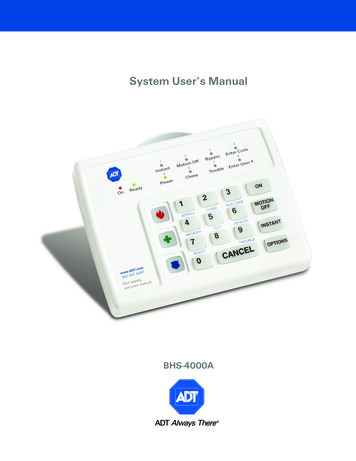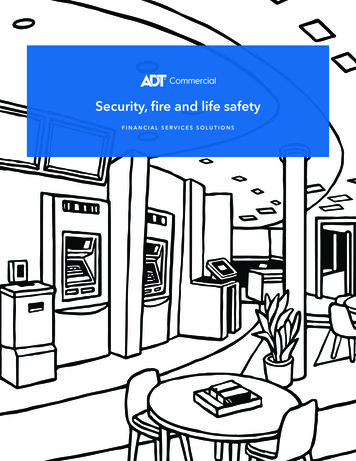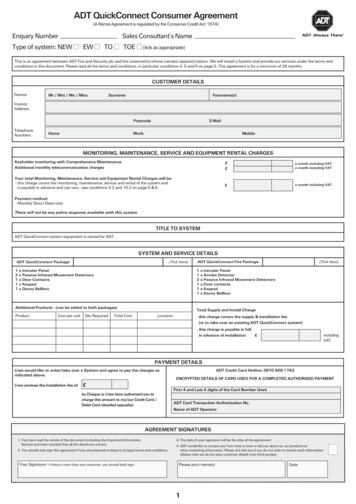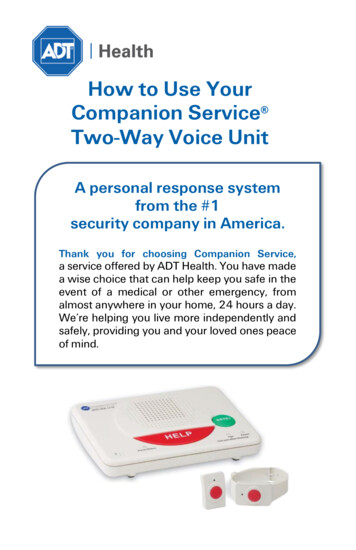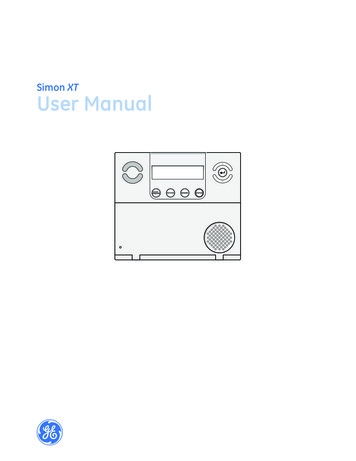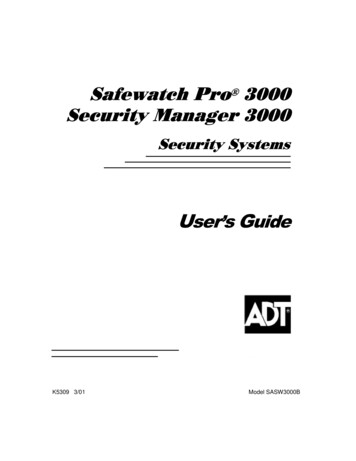
Transcription
6DIHZDWFK 3UR 6HFXULW\ 0DQDJHU 6HFXULW\ 6\VWHPV8VHU·V *XLGHK5309 3/01Model SASW3000B1
IMPORTANT!PROPER INTRUSION PROTECTIONFor proper intrusion coverage, sensors should be located at every possiblepoint of entry to a home or commercial premises. This would include anyskylights that may be present, and the upper windows in a multi-level building.In addition, we recommend that radio backup be used in a security system sothat alarm signals can still be sent to the Customer Care Center in the eventthat the telephone lines are out of order (alarm signals are normally sent overthe phone lines).EARLY WARNING FIRE DETECTIONEarly warning fire detection is important in a home. Smoke and heat detectorshave played a key role in reducing fire deaths in the United States. With regardto the number and placement of smoke/heat detectors, we subscribe to therecommendations contained in the National Fire Protection Association'sNational Fire Alarm Code (NFPA 72). These recommendations can be found onpage 34 of this manual. ERXW 7KLV 0DQXDOThis manual is a step-by-step guide that will acquaint you with the system'sfeatures and benefits. It defines the components and their functions, describestheir operation, and provides clear step-by-step instructions for normal andemergency procedures. Keep this manual in a convenient place so that you canrefer to it as necessary.–2–
7DEOH RI &RQWHQWVSystem Overview. 5Introduction . 5System Basics . 5About The Touchpads . 8General Information. 8Functions of the Touchpads . 10Entry/Exit Delays . 12Exit Delay . 12Entry Delay. 12Exit Alarms. 13Checking For Open Zones. 13Using the [ ] Key . 13Arming the System . 14Stay Mode: Arms Perimeter Only, Entry Delay On. 14Night-Stay Mode: Arms Perimeter Only, Plus Selected Zones . 14Instant Mode: Arms Perimeter Only, Entry Delay Off. 14Away Mode: Arms Entire System, Entry Delay On. 14Arming Commands. 15Single Button Arming . 16Single-Button “Step” Arming. 16Using the Keyswitch. 17Using the Keyswitch . 17Disarming and Silencing Alarms . 18Using the [OFF] key. 18Bypassing Protection Zones . 19Using the BYPASS Key . 19Quick Bypass . 20Chime Mode . 20Viewing Current Date and Time . 21Viewing the Current Date and Time. 21Setting the Date and Time. 21Panic Keys . 22Using Panic Keys. 22–3–
7DEOH RI &RQWHQWVMacro Key Programming & Usage . 23About Macro Keys . 23Example of Macro Programming. 24Using a Programmed Macro Key . 24Using Device Commands. 25Paging Feature . 26About Automatic Paging . 26Single Button Paging . 27Latch Key Paging . 27Security Codes & Authority Levels . 28About Security Codes . 28Authority Level Definitions . 28To assign User Codes and Attributes. 29Accessing Other Partitions (GOTO Command and Multi-Partition Arming). 30About Accessing Partitions . 30Using the GoTo Command. 31Multi-Partition Arming. 31Common Zone Operation . 32Scheduling . 33About Scheduling . 33Creating Schedules. 33Event Logging Procedures . 35About Event Logging. 35Viewing the Event Log. 35Testing the System (To Be Conducted Weekly). 36Trouble Conditions. 37Maintaining Your System . 40Fire Alarm System (If Installed). 41Quick Guide to Basic System Functions . 45Summary of Audible/Visual Notifications . 46Regulatory Statements and Warnings . 48Charts of Your System's Features. 50–4–
6\VWHP 2YHUYLHZ,QWURGXFWLRQCongratulations on your ownership of an ADT Partitioned Security System. You'vemade a wise decision in choosing it, for it represents the latest in security protectiontechnology today, and millions of premises are protected by ADT systems.This system provides: Three forms of protection: burglary, fire* and emergency. At least one touchpad which provides control of system operation and displaysthe system’s status Various sensors for perimeter and interior burglary protection Smoke or combustion detectors* designed to provide early warning in case of fire.Your system may also have been programmed to automatically send alarm or statusmessages over the phone lines to a Customer Care Center.* Commercial installations and some residential systems may not include fireprotection – check with your installer.6\VWHP %DVLFVBurglary Protection There are four modes of burglary protection: Stay, Night-Stay, Away, Instant.STAY: arms perimeter zones only and entry delay is onINSTANT: same as STAY, except entry delay is offNIGHT-STAY: arms perimeter zones and selected interior zones; entry delay onAWAY: arms perimeter and all interior zones, entry delay is on You can BYPASS selected zones while leaving the rest of the system armed. CHIME mode alerts you to the opening of protected doors and windows while thesystem is disarmed.Fire Protection Fire protection is always active (if installed) and an alarm sounds if a firecondition is detected If necessary, you can manually initiate a fire alarm using the touchpad. Refer to the Fire Alarm System section for information regarding fire protection,smoke detectors and planning emergency exit routes.Security Codes You were assigned a 4-digit security code during system installation. Use your security code when arming and disarming the system, and whenperforming other system functions. Other users can be assigned different security codes. User codes can be assigned different authority levels, which define which systemfunctions a particular user can perform.–5–
6\VWHP 2YHUYLHZ &RQWLQXHGZones and Partitions The system sensing devices have been assigned to various “zones,” which arespecific areas of protection (e.g., front door, kitchen window, etc.). Zone numbers are displayed at the touchpad when an alarm or trouble conditionoccurs on a sensor. Partitions provide two independent areas of protection, with each partitioncontaining a group of zones that can be armed and disarmed without affectingother zones or users. Partitioned systems can include a common zone area, which is an area shared byusers of both partitions (such as a lobby in a building). Partition identification: 1 partition 1; 2 partition 2; 3 common zone.Arming, Step-Arming and Disarming Burglary Protection The system must be armed before the burglary protection; can sense intrusions. To arm your system, enter your user code followed by the desired arming key. You can also use the step-arming key to arm the system, if programmed. To disarm the system, enter your user code then press the [OFF] key. Step-arming, if programmed, lets you use a function key to arm the system in oneof three modes by simply pressing the key repeatedly, where:first press arms STAY; second press arms NIGHT-STAY; third press armsAWAY.Alarms When an alarm occurs, both the touchpad and external sounders will sound, andthe touchpad will display the zone(s) causing the alarm. If your system is connected to a Customer Care Center, an alarm message willalso be sent. To stop the alarm sounding, simply disarm the system.Memory of Alarm When an alarm condition occurs, the touchpad displays the number(s) of thezone(s) that caused the problem, and displays the type of alarm. The message remains displayed even after disarming the system, but can becleared with another “off” sequence.–6–
6\VWHP 2YHUYLHZ &RQWLQXHGPhone Access If included, a phone module permits you to access the system via a touch-tonephone, either on-premises or by call-in when away. You can receive synthesized voice messages over the telephone regarding thestatus of the security system. You can arm and disarm the system and perform most function commandsremotely via the telephone, with voice confirmation provided after each commandentry. Complete information regarding the use of this feature is provided in a separatemanual entitled “Phone Access User's Guide” that is supplied with the voicemodule.Paging Feature If programmed, up to four pagers can automatically display certain systemconditions as they occur in your system. The display consists of code numbers that indicate the type of condition that hasoccurred.Function Keys The “A”, “B”, “C”, and “D” keys on the touchpad can be programmed to performvarious functions. Functions include: activate a Panic alarm; arm the system; provide step arming;switch lights on/off; send a message to a pager; display Time/Date; start a MacroScheduling Your system can be programmed to automatically perform certain functions (e.g.,arm the system) at a predetermined time each day.–7–
ERXW 7KH 7RXFKSDGV*HQHUDO ,QIRUPDWLRQYour touchpads allow you to control all system functions. The touchpads feature thefollowing: A telephone style (digital) keypad Liquid Crystal Display (LCD) which shows the nature and location of alloccurrences Built-in sounder which will sound during alarms and troubles. The sounder also"beeps" during certain system functions and when depressing any of the keys (toacknowledge the key press). Backlighting of the LCD display windows. Backlighting turns on when entering thepremises through any assigned entry/exit door, or when any touchpad key ispressed. This feature is helpful when a touchpad is located in a dimly lit area.IMPORTANT: If the touchpad beeps rapidly upon entering the premises, it indicatesthat an alarm has occurred during your absence and an intruder may still be on thepremises. LEAVE IMMEDIATELY and CONTACT THE POLICE from a nearby safelocation.There are two basic types of touchpads which are functionally the same, but theyhave different types of displays.Custom English Display 2-line Custom English display touchpads feature a 2-line,32-character alphanumeric LCD which can display systemmessages in friendly English. These touchpads can also beprogrammed with custom zone descriptors. To access thekeys on the touchpad, simply open the swing-down door.English DisplayEnglish display touchpads are functionally identical toCustom English display touchpads, but the LCD displayuses pre-designated words to identify the nature andlocation of occurrences. To access the keys on the touchpad,simply open the swing-down door.–8–
ERXW 7KH 7RXFKSDGV &RQWLQXHG(QJOLVK 'LVSOD\ 7RXFKSDGAWAY:STAY:All burglary zones, interior andperimeter, are armed.Perimeter burglary zones, such asprotected windows and doors, arearmed.NO ACTESTBYPASSNOT READYCHIME BATALARMFIRE CHECK INSTANTAWAYSTAYENGLISH DISPLAY TOUCHPADINSTANT:Perimeter burglary zones armedand entry delay is turned off.BYPASS:This appears when one or more burglary protection zones have beenbypassed.NOT READY:NO AC:AC:CHIME:BAT:Appears when burglary portion of the system is not ready for arming(due to open protection zones). The system is ready to arm when thismessage disappears and the READY indicator light comes on.Appears when AC power has been cut off. System is operating onbackup battery power.Appears when AC power is present.Appears when the CHIME feature is activated.Low battery condition in a wireless sensor (if zone number displayed)or low system battery (if no zone number displayed).ALARM:Appears when an intrusion has been detected and the system is armed(also appears during a fire alarm or audible emergency alarm).Accompanied by the protection zone in alarm.CHECK:Appears when a malfunction is discovered in the system at any time orif an open is detected in a FIRE zone at any time or a fault in aDAY/NIGHT burglary zone during a disarmed period. Accompanied bya display of zone number in trouble.FIRE:Appears when a fire alarm is present. Accompanied by a display of thezone in alarm.A FIRE display, accompanied by a display of zone 95, also appearswhen a fire alarm is manually activated.–9–
)XQFWLRQV RI WKH 7RXFKSDGV1. DISPLAY WINDOW.Custom English Display Touchpads: 2line, 32-character Liquid Crystal Display(LCD) touchpads that display protection pointidentification, system status, and messages.English Display Touchpads: Displayprotection zone ID and system statusmessages using pre-designated words in theLCD display.9.8 CODEUsed to assign additional usercodes for other users of the system.10.9 CHIMETurns CHIME mode on and off.When on, the opening of windows or doorswhile the system is disarmed will sound 3beeps at the touchpad(s).11. READYUsed to display all open protectionzones.2.1 OFFDisarms burglary portion of thesystem, silences alarms and audible troubleindicators, and clears visual display afterproblem's correction.3.4.Arms the entire burglary system,perimeter and interior.2 AWAY3 STAYArms perimeter portion of burglarysystem only. Interior protection is not armed,allowing movement within premiseswithout causing an alarm.5.This is not a Function key. Used4only as a numeric key.6.5TESTTests the system and alarmsounder if disarmed. Refer to Testing TheSystem section for test procedures.7.6 BYPASS Removes individual protectionzones from being monitored by the system.8.7INSTANT Arms in manner similar to theSTAY mode, but without the entry delayfeature. Entering via an entry/exit door willcause an instant alarm.† Note: Keys 1 OFFthrough 3 STAY12.#This key can be used for "QuickArming" of the system without use of asecurity code (if programmed).13. KEYS 0–9†: Used to enter your securitycode(s).14. READY INDICATOR: (GREEN) Lit whenthe system is ready to be armed (no faultspresent). While the system is disarmed, thisindicator will go on and off as protectionzones are closed and opened.15. ARMED INDICATOR: (RED) Lit when thesystem has been armed.16. INTERNAL SOUNDER: The built-insounder mimics the alarm sounder duringalarms, and will also "beep" during certainsystem functions.17. FUNCTION KEYS: Keys A, B, C, D mayhave been programmed for a variety offunctions, including panic (emergency)functions. For details, see the Function Keyssection.and 2 AWAY through 7INSTANT each perform theirassociated companion system functions (OFF, STAY, AWAY, INSTANT, etc.) whenpreceded
CHECK: Appears when a malfunction is discovered in the system at any time or if an open is detected in a FIRE zone at any time or a fault in a DAY/NIGHT burglary zone during a disarmed period. Accompanied by a display of zone number in trouble. FIRE: Appears when a fire alarm i
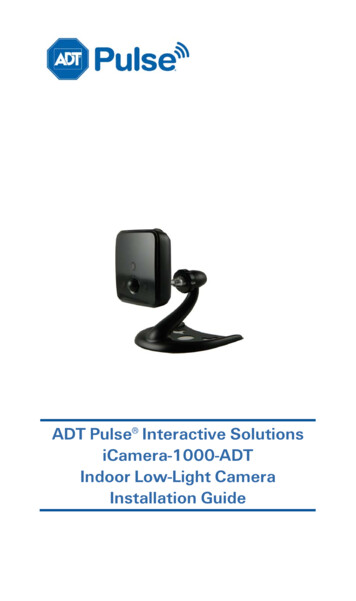
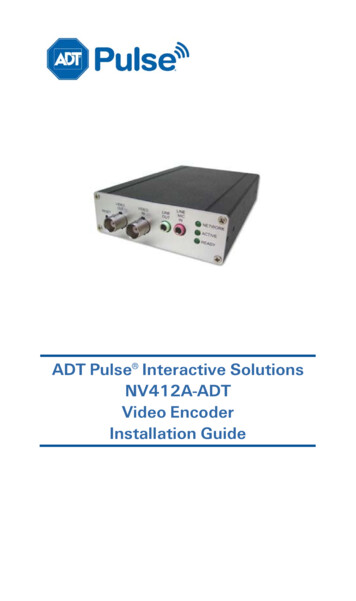
![VWHPV 0RGHUQL]DWLRQ 3URMHFW 56 VHFWLRQ KWWS](/img/7/hi-dhs-ivv-monthly-status-rpt-february-2019-final.jpg)


